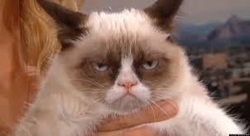 The Wonderful Grumpy Cat
The Wonderful Grumpy Cat | ART
| Architecture
| Engineeering
1. One hero on a single linear chronological journey towards redemption (Hmmmm? Really?) |
| Linda Aronson |
|
 The Wonderful Grumpy Cat The Wonderful Grumpy Cat Am I mad? How can I possibly say there are six main families of structures, with 18 different sub categories and hybrids forming all the time? People are sometimes skeptical about this, indeed sometimes get a bit cross about it. Personally I’d say that what is really odd is the idea there is only one type of storytelling structure in screenwriting. Why should screenwriting be the only form of human endeavor that can be done in only one rigid way (although actually it demonstrably isn’t)? Just as a bit of fun, let’s look at a few other art forms, other forms of creative structure. Here, off the top of my head and in absolutely no order at all, is my layperson’s examples of main categories in these spheres (not even counting sub categories and hybrids), about which I think a person in the relevant profession would need to possess some awareness. Read these and then consider whether suggesting that there is only one form of structure for telling a story seems likely or sensible. Would you go to a music school that forced you to write only jazz? Or an architecture school that insisted there was only one design for a domestic dwelling? In short, in screenwriting as in all spheres of human activity there is more than one way to skin a cat. My thanks to Wikipedia (which will give you many more than I have listed here) and best wishes for your next trivia night. Apologies to all cats for any offense caused. I agree that it is a barbaric expression. No animals were hurt during the creation of this post...
0 Comments
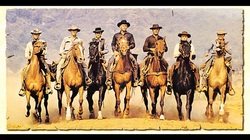 The Magnificent Seven The Magnificent Seven I've been having some correspondence with a writer who has written a film that has multiple storylines and multiple protagonists but been told by a number of people who have read the script to pick a hero or heroine and make the film about just that character. I thought readers might be interested in the issue since it’s one that often comes up. As you’ll all be aware I am a great supporter of films that involve multiple protagonists and multiple storylines. I think scripts are often wrecked because a script that has its interest specifically in being about a group is turned into a story about one of the group - with the other members of the group simply appearing from time to time being, well, colorful. This is a bit like turning the The Full Monty into a story about one man putting on a striptease show not a group, or perhaps making The Magnificent Seven into The Magnificent One. Some stories are about groups, full stop, and they won’t work with a ‘one hero’ structure. But films that use multiple storylines each with their own protagonist are not always the answer. Many fine films consist only of one hero on a single linear chronological journey. It depends on the story you want to tell. Content dictates structure. If you do decide to use multiple storylines (and there are many different types of structure that will permit you do that ) you will hit all kinds of challenges. These include the need to have connections between your storylines (or your audience will rightly be asking ‘what is all this about? Why these characters and no others?’) and you will always have a battle to create and maintain pace, meaning, closure and how and when to jump between stories - simply because all parallel narrative scripts do. It’s the nature of the beast. But there are many types of multiple storyline structure Note that I said there that there are many types of structures that use multiple storylines and multiple protagonists, not just one. For example, Pulp Fiction has multiple storylines and multiple characters but it's structured very differently from The Full Monty or Traffic, both of which also have multiple storylines and protagonists. This is an important point to remember because conventional screenwriting theory lumps together all types of film that don't fit the one-hero-on-a-single-chronological journey. They are clearly not all the same. I stress, the plotting and character problems in a film like Nashville are completely different from such problems in a film like Pulp Fiction. In The 21st Century Screenplay I have isolated six categories with many subcategories (for example, there are many different types of flashback). But meanwhile, hybrids are appearing all the time and we must expect more. Screenwriting structures are diversifying all the time. Here is what the writer said: Writer to Linda
Linda's reply Sticking to your guns... First of all I’d say don’t stick to your guns about anything before you’re very sure that the people picking the problems are wrong. Maybe they’re right and you do need a one hero storyline because the story material is really mostly about one character. Alternatively, assuming that what you are intending to transmit does require a group of characters, maybe your readers have picked inadequacies in the way you are creating your group story but are offering the wrong solution. Very often when people tell a writer to focus on one hero and not the group it’s a case of there being something wrong with the multiple protagonist script but the wrong solution is being offered. Perhaps your multiple protagonist films is indeed coming over as characters in search of a plot and you need to invent a plot that unites and explains them. Maybe there is, generally, insufficient connection between the storylines so that they feel random. Maybe you are just not getting what’s in your head on to the page. You are certainly not convincing your readers that your film is at present holding together as you feel it is. I was given this very good piece of advice many years ago by a very good and very experienced producer: ‘If one reader thinks there’s a problem, it might be just their idiosyncratic view. If two people have the same problem, sit up and listen. If three readers have the same problem you have some fixing to do’ 'Logically impossible to please all readers?' The writer says: Each person that's read script identifies with a different character according to (reader's) gender, sexuality, colour, educational/cultural values & personal/sexual prudery = for me this is a positive, it's what I aimed for. Ergo it's logically impossible for me to 'please' all readers. I'd say - not necessarily. If the characters are sufficiently connected and all contribute towards an interesting message you may be able to please them all. They are clearly not pleased at the moment, so you have a choice either to dismiss their opinion and seek another audience or to do something to make them enjoy the script. Not one main protagonist The writer adds There isn't ONE main protagonist - each character/character's storyline is strong enough for a film in its own right = for me a positive. Fine! Lots of great films have multiple storylines and multiple protagonists, but there needs to be a connection between them that answers the question: ‘why these six characters and not another six characters?’or your audience will get restless and irritated. They will be asking (and who can blame them?) 'Why these characters? What’s the connection? What’s the intention of the film?' Is the writer confusing multiple protagonist form with tandem narrative structure? I haven't read the script, but the more I look at the writer's comment that 'each character/character's storyline is strong enough for a film in its own right' the more I think the writer might be confusing what I term 'multiple protagonist form' (which is about a group of characters on a joint 'adventure' which is either a quest, a reunion or a siege, social or physical) and another sort of group story which I've termed tandem narrative, which also has multiple storylines, each with its own protagonist, but which is very different and needs handling in a very different way. What is tandem narrative? I've explained this as 'equally important storylines running together in tandem in the same time frame on the same theme'. It's the form of films like Traffic or Nashville, where characters have separate storylines – rather than being involved together in a joint quest, siege or reunion. Tandem films follow individual characters off on their own journeys. Sometimes these characters don't even know each other. From the sound of things I think the script is a tandem narrative. But I think the writer might be trying to think of this according to the guidelines I've set out for multiple protagonist form, which don't apply. I'll discuss this further later. First let's look at the issue of connection in these films. Connection in Multiple Storyline films, Whether you're using tandem narrative or multiple protagonist narrative (or any other kind of parallel narrative for that matter) it's not enough simply to have fascinating characters. From the audience’s point of view the issue is not that the characters are each individually fascinating. It’s why the filmmakers have put these particular characters together in a film. The audience questions are, as I've said : ‘why these characters and no others?’ ‘What is the connection?’ ‘What is the intention behind the film?’ And crucially: 'Why am I sitting here watching this?’ If there is no proper connection, people will feel resentful. For example, many people reject the film Babel out of hand because they felt the Japanese girl’s story was insufficiently connected to the others. No matter that they loved the rest of the film. Babel by the way is in the form I've termed a 'fractured tandem' film, that is, it has equally important stories on the same theme but is fractured. How to make connections in tandem narrative films Tandem films are normally connected by a theme. For example, a simple type of connection in film about six people having very separate adventures would be something like: all six are versions of ‘a bizarre person living in London’ with the theme being: ‘bizarreness in all its forms is difficult to cope with but is something we need in this world’. Typically in these films connections are made in some or even all of the following ways. 1. connections through date (e.g. six differently bizarre people are having their separate adventures in London on the same day ) 2. through place (e.g. six differently bizarre people are having their separate adventures in the same part of London on the same day) 3. through an object (e.g six differently bizarre people are having their separate adventures in the same part of London on the same day and they all, one after the other, sit in the same seat on the same bus as it travels its designated route up a major road in their area). 4. connections through plotlines – that is, characters might appear in more than one storyline. 5. conections through a 'Macro Plot'. There is often what I call a macro plot, that is, an umbrella plot line on the same theme as all of the other stories, but one that links all of the differently bizarre characters together physically AND by theme. For example London is blanketed by a terrible fog (symbolic of the confusion and anonymizing aspects of city life which makes us need more bizarreness in our lives), that is causing pneumonia and traffic accidents to the populace, including the bizarre characters. The writer concludes I will however fight with myself to form a character hierarchy & see what that brings forth... My issue is character democracy Let's pause here. You're not being asked to create a character hierarchy. This comment is another reason that I feel you might be getting confused with multiple protagonist form, in which you have a range of different version of the same type of protagonist, including what I've called 'the instigator', that is, the protagonists who causes the story. The instigator in the multiple protagonist film The Full Monty is the Robert Carlyle character, the man who has the idea of the striptease. I'd say your issue is to explain what is similar about your characters, why they have not been chosen at random. Regarding 'character democracy' I think you have to ask yourself here: ‘to what end?’ What is your intention in putting these particular characters into a film together? Sometimes it helps with this sort of thing to ask yourself what the audience is supposed to be thinking and feeling and discussing when they leave the cinema. Sometimes this can clarify your intentions. Or is it consecutive stories form? There are, as often happens in these parallel narrative forms, different ways to tell our story. We could, for example, tell the stories of our six differently bizarre characters in yet another way. Let's imagine we use the idea of each of the six using the same bus seat on the same day. You could construct the film by following each of the characters in turn off the bus and into their own story. Once that story is complete or semi-complete, you could return to the bus with the next bizarre character getting on. You'd then somehow unite the characters at the end. That structure would be a form I've given the name of 'consecutive stories'. You can have that in simple or fractured forms. My hunch is that our writer is thinking of a tandem narrative structure. But do you need to invent a hybrid? More and more I'm being asked to help with complex film scripts that are blending different types of parallel narrative. You may need to create your own particular hybrid. How to do this? I'd suggest you start by looking at what I've isolated, checking my guidelines in The 21st Century Screenplay and seeing how you can merge them, always keeping an eye on pace, connection, meaning and closure. That is usually a lot of help. After that, unfortunately, you are on your own. Writing alas isn't easy. Ever wondered why top writers can command such large sums? You get the picture. To sum up... In conclusion, for anyone wrestling with this sort of problem, I suggest checking out first the many articles on this site under the tab Practical Writing Advice then look at my chapters in The 21st Century Screenplay on parallel narrative, particularly the chapters on Tandem Narrative and Multiple Protagonist narrative. These explain what plot and character components work in successful films of each kind. Also read the section in that book entitled 'Lost in the Telling'. This includes discussion of Multiple Protagonist and Tandem films that don't work - and crucially, why.Make doubly sure that you have chosen the particular structure that suits the story you want to tell. 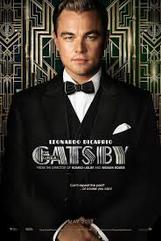 November’s Advanced Screenwriting Newsletter Hi everyone. This is an extract from my advanced screenwriting newsletter. You can read the whole article in the November issue , which you can access by going to the subscription form on this page and clicking 'Previous Campaigns'. If you'd like what you see you can then subscribe to the newsletter by completing the sign-up form. You'll then join our group of people who are interested in how to plan, write and edit film and TV scripts that don't fit the conventional one-hero-on-a-single three act journey. You'll also get special subscribers' access to discounts on my webinars, consultancies, videos etc. etc . What is Double Narrative Flashback? First of all, let's just confirm what double narrative flashback actually is. It’s the kind of flashback structure you see in films like The Great Gatsby, Blue Jasmine, The Usual Suspects, Citizen Kane or Slumdog Millionaire and many more. I gave it that name to describe its structure. That way, the name remains a constant reminder of what we have to do to create the structure.The name says exactly what the structure is (hence what you have to do): two narrative lines plus flashback. You have two storylines, one in the past (a big one) and one in the present (usually much smaller, sometimes very small indeed) and the action of the film jumps between the two, with the two storylines joining again either three quarters of the way through the film or at its end. It’s the most difficult kind of flashback, requiring a different kind of mindset and operating to all kinds of rules that just don’t apply in conventional linear narrative. Hence, it’s no surprise that it often causes trouble, even to the most experienced of writers. The story in the present is what causes most problems Over the years I’ve noticed that it’s the story in the present that causes writers the most problems. The three main problems are: 1. The story material isn’t suited to double narrative flashback 2. There is insufficient or no mystery in the story in the present 3. The film is opening on the wrong scene in the present for the flashbacks to work I think the reason writers have problems with the story in the present is that they aren’t really interested in it. I can really sympathize. When you’re writing a double narrative flashback story, what you’re in love with - your reason for writing - is the story in the past. So you don’t really care about the story in the present. It feels like a necessary evil. You want to rush through it in order to get back to the past. However, if you want your story in the past to work properly, the evidence suggests that you must pay a great deal of attention to the story in the present, because if it’s not properly constructed it will drag the script down, even kill it. Unless your story idea has actually presented itself to you with a strong story in the present, you will need to make a conscious effort to create and fall in love with a story in the present (even if it’s very short indeed). You won’t regret it. You can do wonderful things with the story in the present and end up with two magnificent stories – look at Blue Jasmine Problem 1 The story in the present is redundant (in other words, do you need flashback at all?) I spend a lot of time suggesting to people with problem double narrative flashback films that their film doesn’t need double narrative flashback at all. Remember, if you use double narrative flashback you have to create a compelling unfolding MYSTERY in the present that you keep returning to, a story that really involves the audience, or they’ll get bored. You have to keep servicing that story, taking its protagonist forward, creating a plotline. It’s hard enough to create one good story, let alone two that you have to interweave. So think seriously whether you need it. If you don’t need it, the story in the present can become a millstone around your neck, Possible Fix 1 Is Preview Flashback the answer? Perhaps you do need a flashback, but it’s another sort of flashback, preview flashback, which I discussed in last month’s newsletter. Preview flashback is when the film opens on an event a long way into the story (usually the second act turning point) which provides a hook, then jumps back to the start of the story and continues uninterrupted through to its end, repeating the scene we saw at the opening. It’s really a simple loop, with a scene or segment from the body of film acting as a kind of tantalizing preview. It turns your film into a detective story of sorts because we want to know what that opening sequence is all about. There are all kinds of good narrative reasons for using preview flashback. It can work wonders when properly used. So, if you feel you need flashback, maybe you are feeling a need for preview flashback, not double narrative flashback at all. The big advantage is that you don’t have to keep returning to the present to service a story that you don’t actually need. Possible Fix 2 Is your film inherently a straightforward, linear chronological story? I can explain this better by giving you an example of a film that I think has a redundant story in the present.The film is Paying it Forward. It opens with the story in the present. A young man is upset because his car has been stolen or broken down. A complete stranger gives him the use of his own car. The young man asks the stranger why he is being so generous. The stranger explains that he is repaying a good turn that was done to him by a complete stranger, and this is ‘paying it forward’. Our young man sets out to find the person who (Continued in the November newsletter. You can read the rest of this article and preview the newsletter to see whether you'd like to sign up by going to the newsletter subscription form on this page. On it you'll see a 'Previous Campaigns' link. Click on that, then, if you think the newsletter is something you'd enjoy, you can subscribe. Just note that as an anti-spam protection for you, you'll be asked to confirm your subscription.) Best wishes Linda 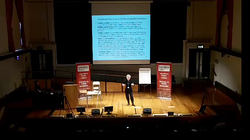 I'm delighted to say that for the first time, in response to many requests and in conjunction with Chris Jones of the London Screenwriters' Festival, the full two-hour film of my lecture at the London Screenwriters' Festival in 2011 is now available to purchase. And if you subscribe to my new Craft Skills Newsletter (which can do in the right hand column on this page) for a limited time you will be able to get a 20% discount. Below is the cover blurb. In 2010, leading screenwriting guru Linda Aronson gave a talk at the London Screenwriters’ Festival that caused a sensation because it exploded the conventional Hollywood approach to screenwriting. The audience of scriptwriters was so anxious to hear more that they kept Linda talking for almost five hours after the lecture was finished. What galvanized the writers were Linda Aronson’s step by step guidelines for planning and writing screenplays like 'Pulp Fiction' or 'The Usual Suspects' that use components like flashbacks, time jumps, multiple protagonists and nonlinear storylines – all elements frowned upon or actively banned by other screenwriting gurus. In 2011 Linda Aronson came back to the London Screenwriters’ Festival and gave an expanded form of the lecture to hundreds of writers, explaining how to construct eighteen storytelling structures apart from the conventional linear, chronological one-hero model. That historical, game-changing lecture was filmed by the London Screenwriters' Festival. For the first time it is now made publicly available by Linda Aronson in conjunction with the London Screenwriters' Festival in a special licence permitting you to view and keep on to download and own on three different digital devices. Watch a trailer. 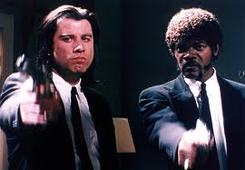 I’m fascinated by that comment you often hear when people discuss non-linearity, to wit: ‘every film has a beginning middle and end – but not necessarily in that order’. And it’s always said dismissively, as if it ends the debate. I find it interesting for a couple of reasons, not the least of which is that it’s totally inaccurate. Nonlinearity in all of the nonlinear structures is (as far as I can see) always arranged so that the end always occurs at the very end of the film, or else, if there are multiple stories, that the film ends on the end of one very powerful story, thereby getting its strong ending from that story’s ending, piggybacking, if you like, on that story’s pull to closure ( as happens in Pulp Fiction for example). There is always a striking or thought-provoking resolution, indeed, nonlinear forms very often clearly show what I call a ‘Rosebud’ twist ( a term referencing Citizen Kane), where only in the final moments is the crucial answer given and this answer turns what seemed to be the message and point of the film on its head. In fact, it’s this pleasing tying-up of threads in an unexpected way that gives nonlinear films much of their pleasure. But let’s move on. What practical help is this little dictum offering? Well, none. To the contrary, not only has it pointed you towards disaster by suggesting that you don’t have to have the end of the story at the end but it begs a dozen questions. Let’s look at it. ‘Every film has a beginning, middle and end but not in that order’. Surely one has to say: ‘ That sounds really useful, but can you please elaborate? Your comment implies that you have come to this conclusion after studying these forms in some detail (otherwise how could you make such a sweeping and apparently authoritative statement?), hence, can you please list these different orders, with examples? Please also explain by what rules, if any, one should choose to use any individual order? Is there any particular form of story content to which each is best suited? And please may I have some technical details here. How precisely am I to jump between the three components? Your argument is premised on there being three distinct parts to the story that one reorders. How do you define those parts? I need to know so that I know precisely where to start the reordering. How do we define the end of the beginning and the start of the middle and the end of the middle and the start of the end? I’m not being smart here. These questions are the ones you really have to ask about the practical mechanics of non-linear. Where you jump stories is vital. Films crash and burn if you jump at the wrong places. Personally, I’ve spent years studying how and when and why nonlinear stories jump at the points that they do, and what effect each sort of jump creates for the audience and what sort of material suits what sort of structure. I had no choice about this because the jumps to and fro between stories make or break the nonlinear film and you need to choose the right structure to tell your story or it won't work. I’d say, for example, that many nonlinear forms open on the second act turning point of one of their stories then jump to its disturbance. My only request is for precision and seriousness. Bottom line. Let’s have a proper debate about nonlinear. 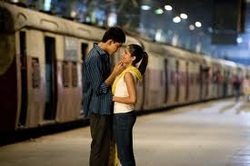 Slumdog Millionaire I'm not sure whether people will be interested in this discussion on Linked In Screenwriting Discussion Group about flashback. I've just contributed to it. I think the writer might have a hybrid flashback form on her hands, actually. Here's the situation. The writer, Melisha, is having problems with flashback. Check out the full discussion on Linked In. I joined the discussion quite late, so I'm just providing Melisha's comments to to others, and then my answer. People are urging caution and some are advising against flashback. MELISHA ORIGINAL QUESTION: Ok so I'm a bit torn. I am working on an adaptation of my own book and the book has a critical flashback scene. Should I open with the flashback scene or leave it to tantalize the audience in Act 2? I know some movies start with the flashback as the opening scene but I think this may make my opening scene last longer than 15 minutes and furthermore the flashback is not the point of the script. What do you all think? This adaptation is killing me. MELISHA RESPONSE 1 : I will approach the script with caution. It is indeed a difficult script to prepare but I'm learning a lot as I go. Do you remember the movie Premonition with Sandra Bullock? I thought this was a good movie that used tons of flashback to tell the story but I was confused the entire time. I don't want to confuse the audience too much but I do have to make these transitions to help the audience understand the antagonist's reason for "stalking" the protagonist. And yes you are right, it was a few centuries ago when they met but only the antagonist is aware of this because he's been living for many centuries. MELISHA RESPONSE 2: Well this particular flashback is a big piece of the puzzle in the story but it is the subplot so I'm thinking I will add it around the end of Act 2. MELISHA RESPONSE 3: Let me further break down my dilimma. I have two main characters who met in the past and its a sort of deja vu thing. The storyline is in the present but I have to flashback twice to introduce the audience to the historical characters. So I opened with the antagonist because his story is important but not as important as the one of the protagonist. His flashback is minimal - about 15 minutes and will have a narrator in the background. Her flashback is the subplot and critical to understanding what is going on in the present so I want to place her in Act 2. I don't know if I should open with his flashback or open in the present and somehow squeeze his debut in somehow like as a character is thinking about something then it changes scenes to the character's thoughts. LINDA's ANSWER Unfortunately I haven't seen Premonition, so I can't comment on that. However, I might be able to help you in structuring your film. As a writer who could never find any answers about flashback I wrote first one then another book on how to structure a whole family of different types of flashback, also how to structure other types of nonlinear film (for example, Pulp Fiction). The latest book (which is more up to date) is called The 21st Century Screeenplay and it's published by Silman James. It's required reading at NYU and Berkeley and lots of other film schools around the world, as well as being used by professionals, so a lot of people are finding it useful so maybe you will too. The good news is that successful flashback films work to clear patterns, based on jumping between past and present in very specific ways at very specific points in the three act structure. In a nutshell, they jump on cliffhangers, but very specific cliffhangers and you must get these right or you'll send the audience in completely the wrong direction. The patterns are so clear that you can use them as templates. There are actually quite a few different types of flashback, each structured differently, so you need to work out which suits your purpose. The rule is content dictates structure. For example, Slumdog Millionaire jumps back and forth between past and present with a storyline in each, whereas Goodfellas starts in the middle of the film with a crucial scene, then jumps back to the start and continues straight through from beginning to end with no more flashbacks. And there's another kind of flashback that I call a 'Life Changing Incident ' flashback, which is an incremental flashback - that is, one crucial event revealed bit by bit- as in Twelve Monkeys or Catch 22. And so on. As I say, each of these types is structured in a different way, with the jumps occurring at different times in each. Yes, you could indeed simply tell the past through exposition, but think of Slumdog Millionaire without the flashbacks, all told through dialogue in the present. It wouldn't be half as vivid. It's hard to comment on how precisely you should structure your film. It could feel very jerky if you open on one character, follow it for fifteen minutes, then switch to another. It may well feel as if we're in another film. My feeling is that your most likely bet is to start in the present at the second act turning point - then jump back to the disturbance of the story in the past. That's how many of these films start. That way, you should avoid the start-stop effect. But I could be wrong here. You may need to start elsewhere. You might need a different structure to suit your purpose. I stress this stuff isn't easy. . I've got some advice on my website www.lindaaronson.com but try to get hold of a copy of one of my books (they're in lots of libraries) because there are all kinds of ways to get in a mess with flashback. Good luck  I'm trying to insert a little video clip that Chris Jones of the London Screenwriters' Festival created of me talking at the Festival, but I'm having trouble. Hmm. Don't you love technology. Watch this space. If you really want to see the video, just check it out here. Meanwhile, to the left is a pic of me chatting to writers after one of my sessions at LSF. Back soon. 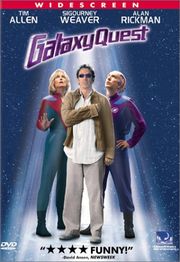 Hello everyone. I hope you've all recovered from this year's fantastic London Screenwriters Festival. And I hope you like my new streamlined website and blog! I've just been running some videolectures from London to students at the Netherlands Film and TV Academy in Amsterdam on how to structure ensemble films, and thinking as I planned my lectures just how very complex the planning and plotting issues are in these films. So it was an interesting coincidence when a very pertinent question and lots of answers appeared on the Linked In Screenwriting forum about how many characters you can use in these sorts of films. If you follow this blog, you'll know that I responded. The most recent question asked about TV, so I replied to that too. I've put my response in here, below this post, and you can see the other responses on Linked in. What is all boils down to really is that you can't approach ensemble films as if they are rather unruly 'one hero on a single journey' films. They are structured in a completely different fashion, as a series of separate stories, with all kinds of particular problems, particuarly with backstory and interweaving (you must interweave in such a way as not to be repetitive, and you have so many story strands, often about unfinished emotional business that your head sometimes spins) So the apparently odd question of 'how many characters...etc' is not odd at all. It's absolutely pertinent. What's scary about the flim industry at the moment is that so many people across all fields believe that you absolutely MUST have only one protagonist. Which wrecks lots of ensemblefilms (in which all of the characters' have stories). Anyhow, I'm delighted that we're all talking about this stuff now, difficult as it is. Here's what I wrote in Linked in when someone asked how many characters in TV series Usually TV series use about six, because there is only sufficient time to handle that number of characters taking the limelinght in your max 50 minute time slot, and people devising TV series agonise about how many and who. For more info on TV writing see my ebook TV Writing The Ground Rules of Series, Serials and Sitcom http://books.google.co.uk/books/about/Television_Writing.html?id=8j1AYBJKWvQC Regarding Ensemble films, they use different structural plans from one-hero films because they are running multiple stories. It's a different set of rules and a different mind set. The question about 'how many characters are too many' goes to the heart of ensemble screenwriting in both film and TV because of the time restrictions on you as you try to tell but control all those stories/story strands. You don't have time for unlimited character numbers unless you use special forms and some of those forms permit more characters than others. Why the time problem? Well, for example if the characters in your film know each other you can have huge amounts of backstory to sneak in about their past interactions and unfinished emotional business as you also try to tell the main group 'adventure'. You can have 17-20 story strands to run. Yes, there are ensemble forms in which you can use more characters (40 I think in Magnolia - although this is a film that has problems with its meaning and closure) but you have to quarantine them in stories or you'll get characters in search of a plot.This is a fascinating but huge topic! Anyhow, if you're interested there's a little video interview I did in Sweden on this sort of stuff on the home page of my site www.lindaaronson.com 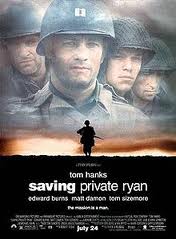 This was a very interesting and crucial question that came up on Screenwriting Group on Linked In , so I answered it. I then thought others who are not on that forum might also be interested because it's so easy for multiple characters to get out of control. Controlling multiple characters is a bit like driving a team of charging horses that all want to go in different directions. You have to know where you want them to take you and how, and that’s where your choice of structure comes in. So none of this is academic, it's all about the nitty gritty of how you create and handle all of these stories. Here is the correspondence. Hope you find it interesting Writer: How many is too many main characters in an ensembled cast? Linda Good question. There are all kinds of plotting issues connected with Ensemble pieces. It's really easy to get into a mess with this kind of piece because the term 'ensemble' is often used very loosely to mean every film that has lots of characters and isn't 'one hero on a single journey'. That means people are lumping togther films as structurally different as Pulp Fiction and American Beauty, which is utterly unhelpful. I have written a lot about how to construct ensemble and nonlinear multiple storyline films in my book The 21st Century Screenplay because, as a writer, nobody could give me answers about how to construct flashback and ensemble films. Okay. I am assuming you are thinking here of feature film about a group of characters with multiple storylines that run simultaneously in the same time frame (If you want to use time jumps, flashbacks etc they are very different structurally and in plotting terms. I also write about that in my book) . There are two main types of structure here, with different plotting issues, each suitable for different kinds of story. The different plotting issues depend on whether you want to do a story about group interacting together, working together in some way on some kind of quest, reunion or siege situation (so your main aim is to explore the group dynamic and the tensions within the group, as in The Full Monty or LIttle Miss Sunshine or The Hangover ) OR whether you want to pursue a group of individuals, who are connected by theme but who go off into their individual stories - as, for example, in Nashville or Traffic, where the themes are, respectively, 'The strange heartbreaking town of Nashville' or 'The unwinnable war on drugs' Obviously, your plotting problems are different if you have to keep a group of characters together on an 'adventure' while exploring the various personality tensions between them, than where you want to have a group of characters who don't, in most cases interact at all. In the first case (which I call ‘Multiple Protagonist’ structure), you need to run a number of story strands that will cover the 'adventure' they're all involved in, plus all of the relationships between the characters now and in the past (if relevant). That's the form that's used in most TV series about groups of doctors, lawyers, cops whatever. It's easier to think of these as 'different versions of the same protagonist'. Your big plotting problem here is that you have so many strands (sometimes about 30) to run that you need to combine several story strands in the same scene. You can usually only properly cover about 6 characters in this form,which is why TV shows usually have a maximum of about 6 or so characters. A little motto to help you work out whether you need this form is that multiple protagonist form is ‘same team, same adventure’ . The other sort of multiple storyline/same linear time frame ensemble movie (Traffic, Nashville, Lantana etc,which I call ‘Tandem narrative, because it’s equally important stories running in parallel in the same time frame) requires you to construct separate stories for each character you’re following as they go off on their separate ‘adventures’. Clearly a different plotting problem. Your motto here is: ‘same theme, different adventures.' In these films you can run three-act, two-act or one-act stories for your various characters. But the big issue about all ensemble films is that you need to plot out each little strand or storyline first THEN interweave. Too easy to get lost! Use index cards, See my website for an intro to all this www.lindaaronson.info My book '21st Century Screenplay covers it in depth. For TV try my ebook 'Television Writing: The ground rules of series, serials and sitcom'. Writer: Linda thank you, I was aiming for a group of characters that go on an adventure and they work together or try to work together but eventually get separated and must overcome the adventure and the same goals separately. That was very helpful. Linda Ah, that's interesting! Because that means that you start out with a group quest, in classic multiple protagonist style, with them all working (and bickering) together (tensions, conflicts, unfinished emotional business as the ‘adventure’ or ‘quest’ proceeds etc – think of Saving Private Ryan, or Galaxy Quest) with a lot of story strands per scene, then, when you split them up you'll be facing tandem narrative problems because you'll have to follow each separately, creating and running separate storylines then jumping between stories as they all try to reach the goal in their separate ways. I’d say about six characters then, max. That’s probably all you’ve got time for. You see what I mean about it being useful to think of them all being versions of the same protagonist, each reaching the goal in their own way? From what you are telling me, that’s what your story is really all about, how these separate versions of the same protagonist each reaches the goal. You’ll have to create a separate little 'hero's journey' for each I’d guess the moment they split up is probably the first act turning point in each of their individual stories. In other words, it’s the same scene for all of their stories. That's means you only have to write the second and third act for each separate storyline, probably pulling them into some kind of group climax (maybe not, though, maybe you’ll do each climax separately ). You are actually doing something a little like Atonement, where the wrongful arrest of Jamie is the first act turning point for all 3 characters, then each goes their separate way and we have a story for each. Multiple storyline films often pivot on the first act turning point like that by the way. For example, the repetitions in Run Lola Run and Groundhog Day also start at the first act turnign point. I'd say six-ish characters then, personally. I'd say with this project, just take your time. Hasten slowly. Work out your storylines first. Remember, because you have so many stories, none of them will be very long. Set up how each character is different from the others in the first act. By the way, maybe another possibility to consider is whether you’d get more mileage character-wise by making them split up into twos – fighting all the way. Just a thought. I hope it’s a great success for you. Good luck with it! 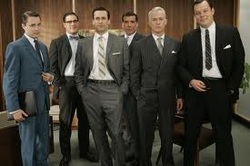 I'm now starting to work with people who are writing games, which is extremely interesting. I find that many of the problems faced by games writers and people writing web-based episodic drama in terms of creating and controlling multiple storylines are very like the problems faced by people writing TV series. So, here's some help for anyone creating multiple storylines (including serial content). It will help always to think of your storylines as a team of unruly horses that you have to drive. Each will always be trying to pull you off course, which, if it happens, will mean the whole project will go off course - and you the writer may be so distracted and so interested in that one horse that you won’t even notice the whole project heading straight for a ditch. This happens to the best of writers because this stuff is just so difficult, so be prepared for it to happen and keep double checking. Writers creating multiple storyline projects on their own (films,TV pieces or games) are articularly prone to going off course because they are one writer running a whole massive project on their own, with nobody to give an objective second view (this is one major reason why TV shows have so many people monitoring scripts as they progress). White boards for each storyline will help you to differentiate and control. Create stories separately, then interweave, pruning back storylines to fit Think in terms of ‘story beats’ and use the old fashioned tried but true TV story-beat estimate for each ‘episode’ to give you somewhere to start in planning how much story you need. The storybeat principle is that one creates A, B, and C stories. You will instantly recognise this from the TV series you have seen. A is the main story (in your case the gang warfare story, linking the gangs) B is the serial element (in your case ongoing fights/love etc within families) C is a short story complete in that episode. For fifty minutes of TV we used to calculate 36 beats: 18 A plot, 12 B plot, 6 C plot. Just stick to that ratio 3:2:1. Index cards are very good idea here, one card per beat. This is just a start. Depending on your material, may want to give more to the B story, or split the B story up into a number of smaller stories. Important point. Plot A will present itself with a timeline. Peg the other stories to that. Remember, a beat is a step in the story, not a scene, and you can combine two or beats in one scene. You may have several scenes to a beat. For more on all of this, see my TV ebook Television Writing: The Ground Rules of Series, Serial and Sitcom and my book on screenwriting, The 21st Century Screenplay pp 127-164 on practical plotting and the chapters on Multiple Protagonist structuree pp. 207-245 (by the way, for people outside of N. America, Google Play books is currently running a specialbargain deal on the ebook of The 21st Century Screenplay). |
AuthorLinda is a screenwriter, novelist and playwright. As well as teaching and mentoring writers around the world, she regularly consults on screenplays at the highest level in the US, UK and Australia. Subscribe to Linda Aronson's Craft Skills NewsletterArchives
June 2017
Categories
All
Note: Hi everyone. For RSS feed from this blog, you'll need feedly.com or theoldreader.com. Thanks, Linda
|